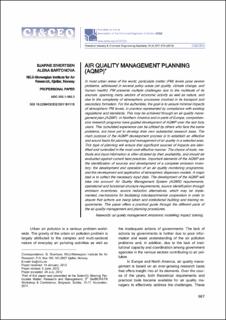| dc.description.abstract | In most urban areas of the world, particulate matter (PM) levels pose severe problems, addressed in several policy areas (air quality, climate change, and human health). PM presents multiple challenges due to the multitude of its sources, spanning many sectors of economic activity as well as nature, and due to the complexity of atmospheric processes involved in its transport and secondary formation. For the authorities, the goal is to assure minimal impacts of atmospheric PM levels, in practice represented by compliance with existing regulations and standards. This may be achieved through an air quality management plan (AQMP). In Northern America and in parts of Europe, comprehensive research programs have guided development of AQMP over the last forty years. This cumulated experience can be utilized by others who face the same problems, but have yet to develop their own substantial research base. The main purpose of the AQMP development process is to establish an effective and sound basis for planning and management of air quality in a selected area. This type of planning will ensure that significant sources of impacts are identified and controlled in a most cost-effective manner. The choice of tools, methods and input information is often dictated by their availability, and should be evaluated against current best practices. Important elements of the AQMP are the identification of sources and development of a complete emission inventory, the development and operation of an air quality monitoring programme, and the development and application of atmospheric dispersion models. Major task is to collect the necessary input data. The development of the AQMP will take into account: - Air Quality Management System (AQMS) requirements; - Operational and functional structure requirements; - Source identification through emission inventories; - Source reduction alternatives, which may be implemented; - Mechanisms for facilitating interdepartmental cooperation in order to assure that actions are being taken; - Institutional building and training requirements This paper offers a practical guide through the different parts of the air quality management and planning procedures. | en_US |

